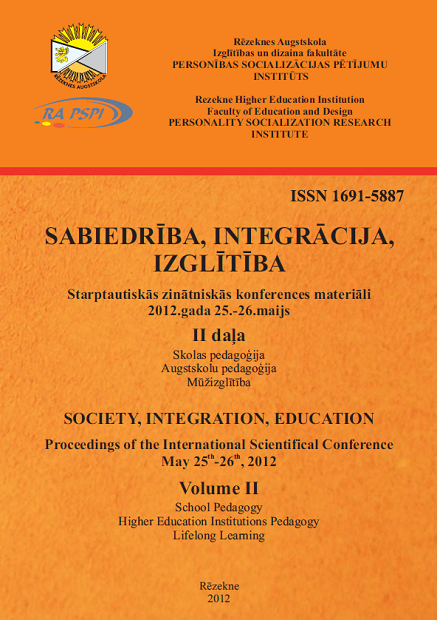EVALUATION OF A PHYSICAL ACTIVITY PROMOTION PROGRAM FOR SENIORS
DOI:
https://doi.org/10.17770/sie2012vol2.143Keywords:
fitness, older adults, outcome expectations, physical activity program, stages of changesAbstract
The aim of the study was to evaluate the impact of the developed programme of physical activities for 60-75 years old seniors. The study sample includes 24 seniors in experimental and 25 persons in control group. The examinations of health related variables, questionnaire about physical activity and factors influencing it, and testing of physical fitness were done. After a one-year period the results of International Physical Activity Questionnaire of the experimental group remained significantly higher than results of the control group (5103.4±1447.05 vs 3796.6±1052.12 MET-min/week; p<0.05). The results of the Exercise Stages of Change and outcome expectations questionnaires let conclude that during classes the participants’ confidence about possible benefits increased and only 15.9% of participants remain in contemplation stage and 13.8% stay in preparation stage. In comparison with the control group the results of lower and upper body strength test significantly improved (p<0.05) as well as the participants of the programme could cover a longer distance in the 6 minute walking test. The changes of the results of health related variables were not statistically significiant (p>0.05).Downloads
References
Blair, S., LaMonte, M., & Nichaman, M. (2004). The evolution of physical activity recommendations: how much is enough? The American Journal Of Clinical Nutrition, 79(5), 913S-920S.
Brawley, L.,R., Rejeski, W.,J., King, A.,C. (2003). Promoting physical activity for older adults: the challenges for changing behavior. Am J Prev Med.25 (3 Suppl 2):172-183.
Craig, C.,L., Marshall, A.,L., Sjöström, M., Bauman, A.,E., Booth, M.,L., Ainsworth, B.,E., Pratt, U., Ekelund, U., Yngve, A., Sallis, J.,F., & Oja, P. (2003). International Physical Activity Questionnaire: 12 country reliability and validity. Medicine and Science in Sports and Exercise, 35(8), 1381–1395.
Ettinger, W. H., Jr., Burns, R., Messier, S. P., Applegate, W., Rejeski, W. J., Morgan, T. et al. (1997). A randomized trial comparing aerobic exercise and resistance exercise with a health education program in older adults with knee osteoarthritis. The Fitness Arthritis and Seniors Trial (FAST). Journal of the American Medical Association, 277, 25-31.
Hughes, S. L., Seymour, R. B., Campbell, R. T., Whitelaw, N., & Bazzarre, T. (2009). Best-Practice Physical Activity Programs for Older Adults: Findings From the National Impact Study. American Journal of Public Health, 99(2), 362.
Kardiovaskulāro slimību (KVS) profilakses vadlīnijas. (2007). Latvijas kardiologu biedrība; sagat. darba grupa: A.Ērglis, A.Kalvelis, A.Lejnieks, V.Dzērve, G.Latkovskis, I.Mintāle, I.Zakke, I.Rasa. Rīga.
Kaupuzs, A., Larins, V. (2011). Affect factors of physical activity in older adults. Sabiedrība, integrācija, izglītība. Starptautiskās zinātniskās konferences materiāli. – Rēzekne, RA. – 638.-648.lpp.
Marcus, B.,H, Selby, V.,C, Niaura, R.,S, Rossi, J.,S. (1992). Self-efficacy and the stages of exercise behavior change. Research Quarterly for Exercise and Sport ;63, 60-66.
McAuley, E, Blissmer, B. (2000). Self-efficacy determinants and consequences of physical activity. Exercise and Sport Science Reviews; 28, 85–88.
Pate, R., Pratt, M., Blair, S.,N., Haskell, W.,L., Macera, C.,A., Bouchard, C., Buchner, D., Ettinger, W., Heath, G.,W., King, A.,C. et al. (1995) Physical activity and public health. A recommendation from the Centers for Disease Control and Prevention and the American College of Sports Medicine. – JAMA., 1 Feb., 273(5).- 402.-407.p.
Physical activity and public health: updated recommendation for adults from the American College of Sports Medicine and the American Heart Association. (2007). Circulation. Aug 28; Vol. 116 (9), pp. 1081-1093.
Physical Activity Guidelines Advisory Committee Report, 2008 To the Secretary of Health and Human Services.- U.S.: Department of Health and Human Services, 2008. - 683p.
Resnick, B. (2000). Functional performance and exercise of older adults in long-term care settings. Journal of Gerontological Nursing, 26, 7-16.
Rikli, R.,E. Jones,C.,J. (1997). Assessing Physical Performance in Independent Older Adults: Issues and Guidelines. Journal of Aging and Physical Activity., 5(3).
Shephard, R., & Bouchard, C. (1995). Relationship between perceptions of physical activity and health-related fitness. The Journal Of Sports Medicine And Physical Fitness, 35(3), 149-158.
Wójcicki, T.,R., White, S.,M, McAuley, E. (2009). Assessing Outcome Expectations in Older Adults: The Multidimensional Outcome Expectations for Exercise Scale. Journals of Gerontology Series B: Psychological Sciences & Social Sciences; 64B(1); 33-40. Available from: URL: http://www.epl.illinois.edu/files/images/measures/MOEES_article.pdf
World Health Organisation Exercise for health. (1995). WHO/FIMS Committee on Physical Activity for Health. Bulletin of the World Health Organisation, -73p.
Zvidriņš, P. (2006). Latvijas iedzīvotāju skaita un vecuma prognozes. Demogrāfiskā attīstība Latvijā 21.gadsimta sākumā. Pētera Zvidriņa red.- R.: Zinātne. -192lpp.


